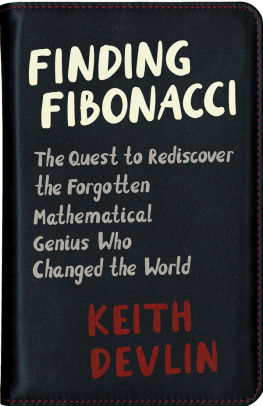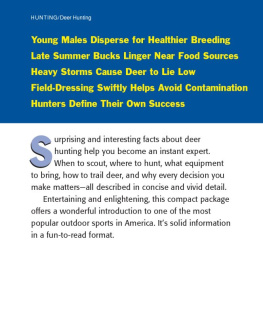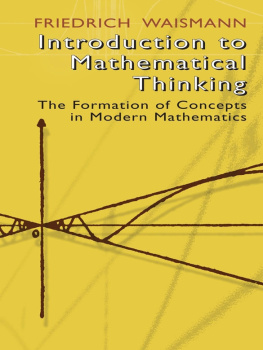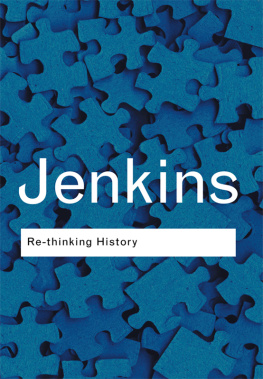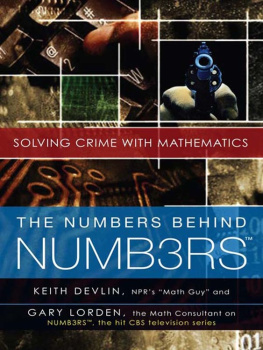Keith Devlin - Introduction to Mathematical Thinking
Here you can read online Keith Devlin - Introduction to Mathematical Thinking full text of the book (entire story) in english for free. Download pdf and epub, get meaning, cover and reviews about this ebook. City: Palo Alto, CA, year: 2012, publisher: Keith Devlin, genre: Science. Description of the work, (preface) as well as reviews are available. Best literature library LitArk.com created for fans of good reading and offers a wide selection of genres:
Romance novel
Science fiction
Adventure
Detective
Science
History
Home and family
Prose
Art
Politics
Computer
Non-fiction
Religion
Business
Children
Humor
Choose a favorite category and find really read worthwhile books. Enjoy immersion in the world of imagination, feel the emotions of the characters or learn something new for yourself, make an fascinating discovery.

- Book:Introduction to Mathematical Thinking
- Author:
- Publisher:Keith Devlin
- Genre:
- Year:2012
- City:Palo Alto, CA
- Rating:4 / 5
- Favourites:Add to favourites
- Your mark:
- 80
- 1
- 2
- 3
- 4
- 5
Introduction to Mathematical Thinking: summary, description and annotation
We offer to read an annotation, description, summary or preface (depends on what the author of the book "Introduction to Mathematical Thinking" wrote himself). If you haven't found the necessary information about the book — write in the comments, we will try to find it.
Introduction to Mathematical Thinking — read online for free the complete book (whole text) full work
Below is the text of the book, divided by pages. System saving the place of the last page read, allows you to conveniently read the book "Introduction to Mathematical Thinking" online for free, without having to search again every time where you left off. Put a bookmark, and you can go to the page where you finished reading at any time.
Font size:
Interval:
Bookmark:
Introduction to
Mathematical Thinking
Keith Devlin
Keith Devlin, 2012
Publisher:
Keith Devlin
331 Poe St, Unit 4
Palo Alto, CA 94301
USA
http://profkeithdevlin.com
Keith Devlin, 2012
All rights reserved. No part of the material protected by this copyright notice may be reproduced or utilized in any form, electronic or mechanical, including photocopying, recording, or by any information storage and retrieval system, without written permission of the copyright owner.
Publication data
Devlin, Keith, Introduction to Mathematical Thinking
First published, July 2012
ISBN-13: 978-0615653631
ISBN-10: 0615653634
Many students encounter difficulty going from high school math to college-level mathematics. Even if they do well at math in school, most students are knocked off course for a while by the shift in emphasis from the K-12 focus on mastering procedures to the mathematical thinking characteristic of much university mathematics. Though the majority survive the transition, many do not, and leave mathematics for some other major (possibly outside the sciences or other mathematically-dependent subjects). To help incoming students make the shift, colleges and universities often have a transition course.
This short book is written to accompany such a course, but it is not a traditional transition textbook. Rather than give beginning college students (and advanced high school seniors) a crash course in mathematical logic, formal proofs, some set theory, and a bit of elementary number theory and elementary real analysis, as is commonly done, I attempt to help students develop that crucial but elusive ability: mathematical thinking. This is not the same as doing math, which usually involves the application of procedures and some heavy-duty symbolic manipulations. Mathematical thinking, by contrast, is a specific way of thinking about things in the world. It does not have to be about mathematics at all, though I would argue that certain parts of mathematics provide the ideal contexts for learning how to think that way, and in this book I will concentrate my attention on those areas.
Mathematicians, scientists, and engineers need to do math. But for life in the twenty-first century, everyone benefits from being able to think mathematically to some extent. (Mathematical thinking includes logical and analytic thinking as well as quantitative reasoning, all crucial abilities.) This is why I have tried to make this book accessible to anyone who wants or needs to extend and improve their analytic thinking skills. For the student who goes beyond a basic grasp of logical and analytic thinking, and truly masters mathematical thinking, there is a payoff at least equal to those advantages incidental to twenty-first century citizenship: mathematics goes from being confusing, frustrating, and at times seemingly impossible, to making sense and being hard but doable.
I developed one of the first college transition courses in the late 1970s, when I was teaching at the University of Lancaster in England, and I wrote one of the first transition textbooks, Sets, Functions and Logic, which was published in 1981. While I understand the rationale behind the more familiar transition courses and textbooks, the course I give today, and along with it this book, seek to serve a much wider audience. (In particular, I no longer devote time to formal, mathematical logic. While logic provides a useful model of mathematical reasoningwhich is the reason it was developed in the first placeI no longer think it is the best way to develop practical, logical reasoning skills.) In adopting this broader, societal perspective, I believe my courseand this bookwill not only still help beginning college and university mathematics students successfully negotiate the transition from high school, it will also help anyone develop better reasoning skills.
For some reason, transition course textbooks are generally hugely expensive, in some cases over $100, which is a lot for a book that likely will be used for at most one semester. This book is designed to accompany transition courses that last only five to seven weeks. For that reason, I decided to self-publish it as a low-cost, print-on-demand book. I did however engage an experienced, professional mathematics textbook editor, Joshua D. Fisher, to go over my entire manuscript prior to publication. The final form of the book owes a lot to his expertise, and for that I am very appreciative.
Keith Devlin
Stanford University
July 2012
Dear reader,
I wrote this book with two kinds of reader in mind: (1) the high school graduate entering college or university who wants to (or could) major in mathematics or some math-dependent subject and (2) anyone who, for whatever reason, wants or needs to develop or improve their analytic thinking skills. Regardless, the focus is on learning to think a certain (very powerful) way.
You wont learn any mathematical procedures from this book, nor will you have to apply any! Though the final chapter focuses on numbers (elementary number theory and the basics of real analysis), the amount of traditional mathematical material I cover on those topics is tiny. The last chapter simply provides excellent examples that have helped mathematicians themselves develop, over time, the analytic thinking skills I shall describe throughout this book.
During the nineteenth century, the need for those analytic thinking skills among the wider, general population grew with increasing democratization and flattening of society, which gaveand continue to giveevery citizen more and more freedom and opportunities to play a significant, self-directed role in business or society. Today, more than ever, good analytic thinking skills are essential for anyone who wants to take full advantage of the opportunities for self-growth and advancement that contemporary democratic societies offer.
I have been teaching and writing books about the patterns of thinking required to succeed in college-level (pure) mathematics for several decades. Yet, it was only in the last fifteen years, as I found myself doing a fair amount of consulting work with industry and government, that I heard first hand that the mathematical thinking skills that were the focus of those courses and books were exactly what business and government leaders said they valued most in many of their employees. Rarely would a CEO or the head of a government lab say that they wanted people with specific skills; rather, their need was for people who had good analytic thinking skills and were able to acquire new specific skills when needed.
As a consequence of the ideas borne out of these divergent, though obviously interconnected experiencesin academia and businessin writing this new book I have, for the first time, tried to structure the development in a way that makes it accessible to a wide audience.
With that said, the remainder of this introduction is directed primarily at the entering (or about-to-enter) college student faced with having to take some (pure) mathematics courses. For the more general reader, the value of what I will say is that the mathematical thinking skills required to master modern pure mathematics are precisely the crucial mental abilities required to succeed in many professions and walks of life, as I just discussed.
* * *
Dear student,
As you are about to discover, the transition from high school mathematics to college-level (pure) abstract mathematics is a difficult one. Not because the mathematics gets harder. Those students who have successfully made the transition will likely agree that college math feels in many ways easier. What causes the problem for manyas I mentioned aboveis only the change in emphasis. In high school, the focus is primarily on mastering procedures to solve various kinds of problems. This gives the process of learning very much a flavor of reading and absorbing the recipes of a kind of mathematical cookbook. At college, the focus is on
Next pageFont size:
Interval:
Bookmark:
Similar books «Introduction to Mathematical Thinking»
Look at similar books to Introduction to Mathematical Thinking. We have selected literature similar in name and meaning in the hope of providing readers with more options to find new, interesting, not yet read works.
Discussion, reviews of the book Introduction to Mathematical Thinking and just readers' own opinions. Leave your comments, write what you think about the work, its meaning or the main characters. Specify what exactly you liked and what you didn't like, and why you think so.

